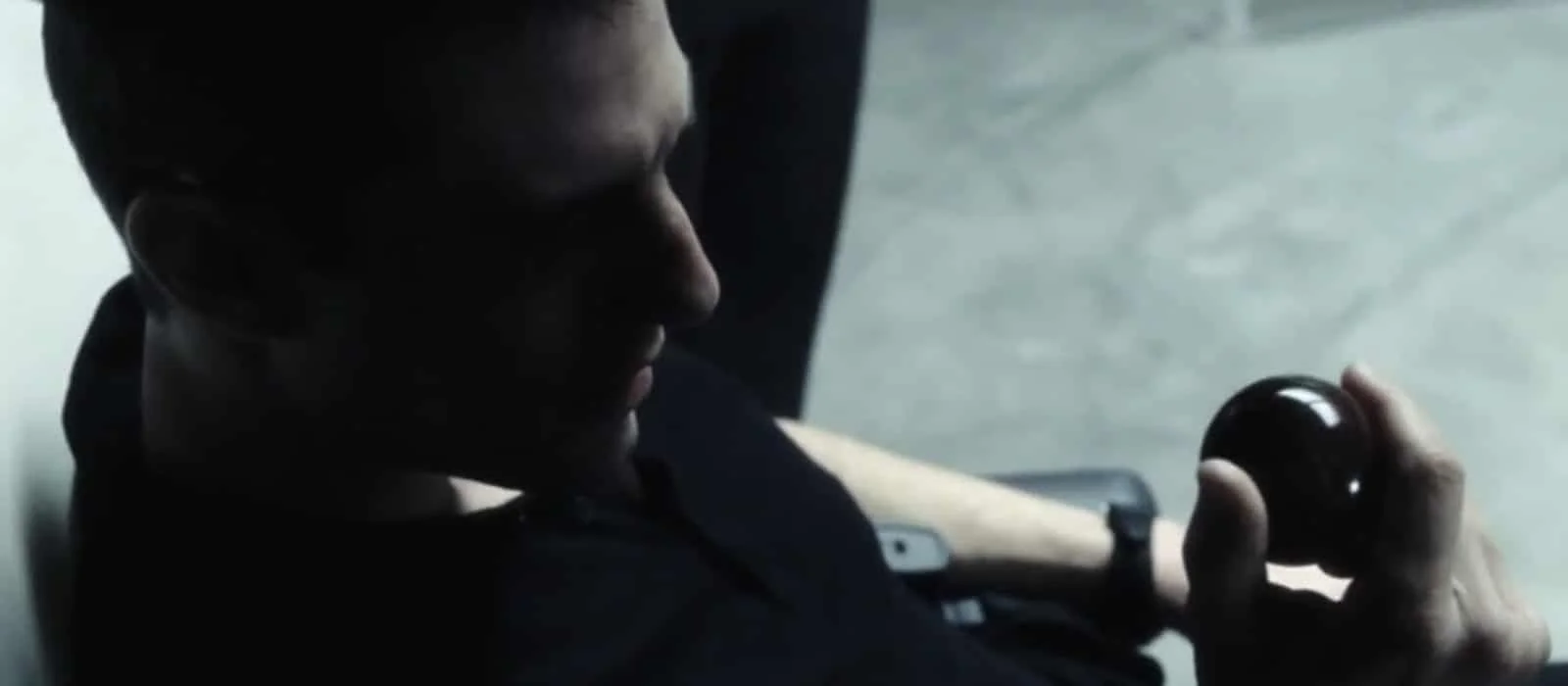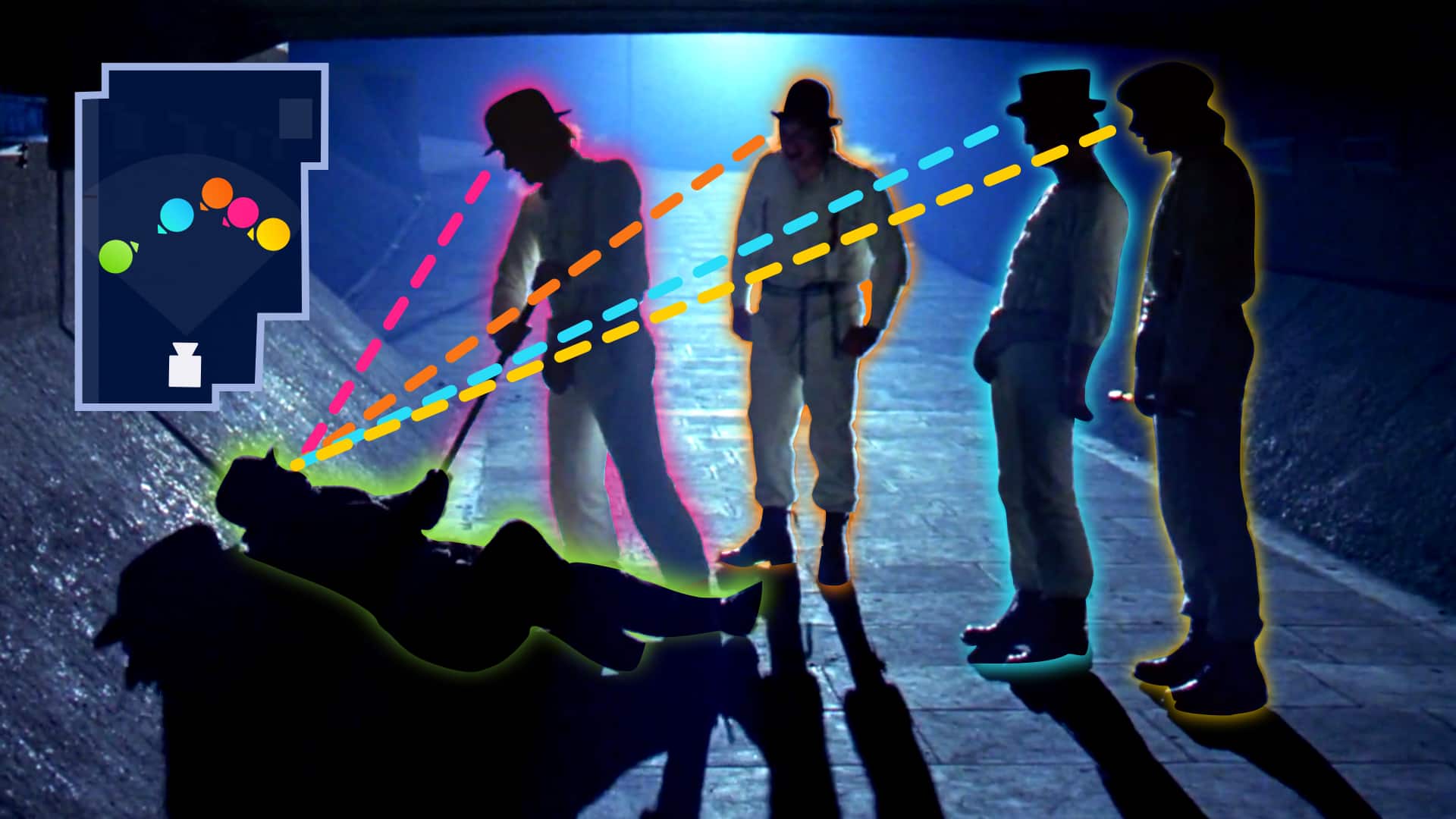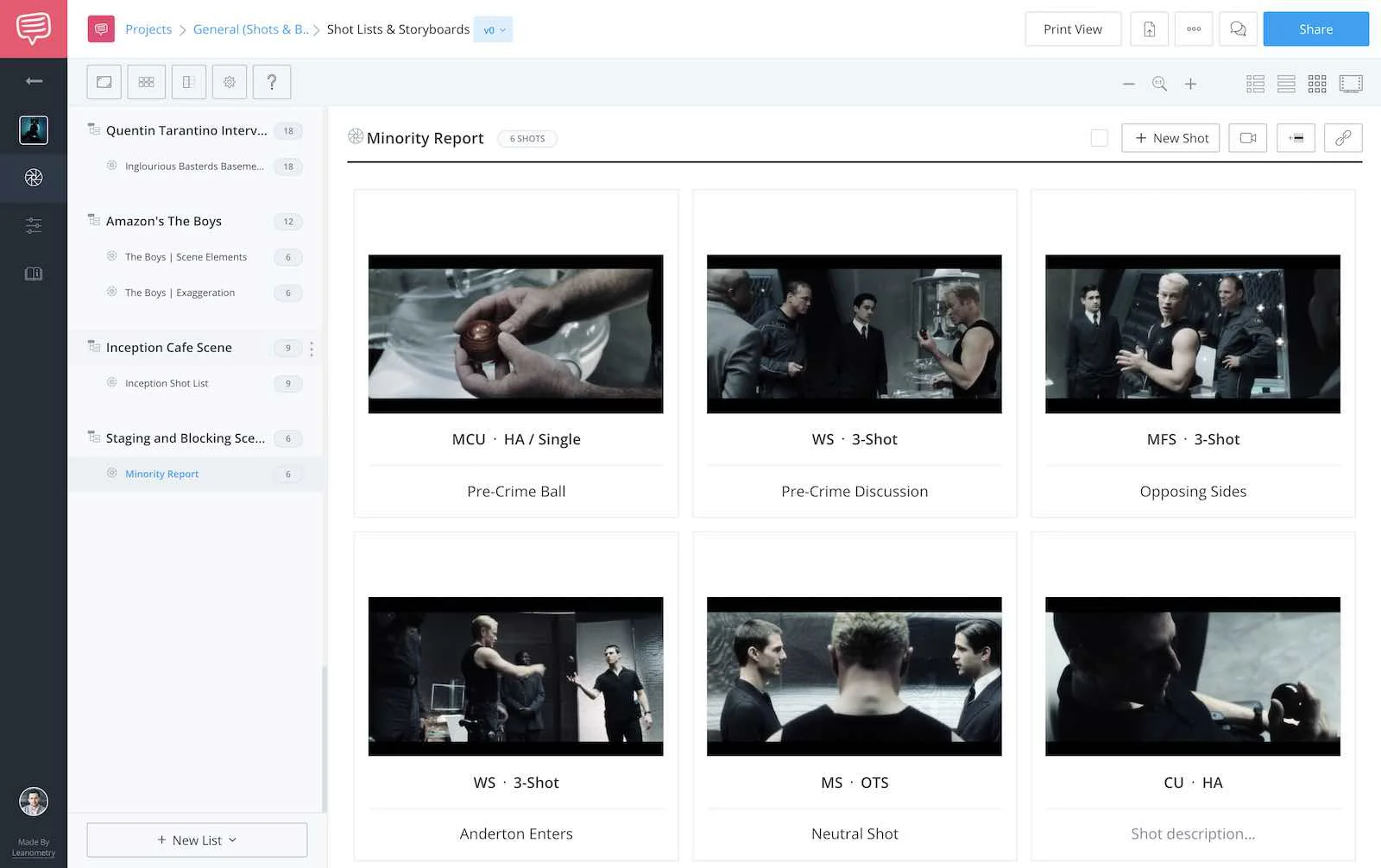Watching a scene is easy, but blocking and staging a scene effectively is a complex dance between actors and your camera. When deciding where to position your actors and your camera, you’re essentially solving a puzzle — a puzzle with more than one solution.
So, how is it done?
In this post, we’re going to show you how three of the great directors in filmmaking history stage and block their scenes in a way that is profound, interesting, and ultimately cinematic. Lezgo.
What Is Blocking
Staging Scenes versus Blocking Scenes
You probably have some questions on how to block a scene, but you also want to learn some helpful staging techniques that elevate your films. Finding a way to mix performance blocking and staging in a scene is the first step in learning how to direct a scene like a true master.
When a director layers camera placement, camera movement, and performance blocking, they can build an almost infinite number of cinematic combinations that can have a significant psychological effect on the viewer that transports them to an emotional destination.
Yet, more often than not, many filmmakers default to standard coverage, and this often means that every film and TV show looks the same.
But before we go too far…
What does blocking actually mean?
Blocking Theater Definition
What does blocking a scene mean?
Performance blocking, or stage blocking, or actor blocking, refers to how one or more actors move around the space during a production. This can be blocking in a stage play or blocking in a scene for movies or television. This can even include a blocking rehearsal that will help to clarify the intention behind each movement and smooth out the motions. Blocking isn’t simply where the actors move through a scene, but also how they interact with their environment. This can include body language.
Blocking as a film term means the same thing as blocking in theater, but stage plays have limited space whereas film blocking might include moving props, vehicles, and multiple locations. It’s important for actors and directors to understand the power of performance blocking.
So, now you have a better idea of what blocking means, but now we need to go over another important aspect of learning how to direct a scene.
This other aspect is known a staging a scene.
What is staging a scene?
Scene Staging Definition
What does staging a scene mean?
Staging a scene is the placement and movement of objects in the frame, as well as the camera in relation to your performance blocking. Staging is far less discussed, yet it is equally important to blocking your scenes.
Most people think of scene staging techniques as a small portion of cinematography, which is partially true. But in addition to lighting a scene, a cinematographer's job also includes working with the director to plan out the camera placement, movement, and area of focus — all in the service of visual storytelling.
When blocking and staging work together in harmony you will be able to create a subtext-rich visual story rather than simply a functional scene.
Let’s look at some examples of staging techniques so we can learn how to block a scene, how to stage a scene, and thus how to direct a scene.
Related Posts
HOW TO BLOCK A SCENE
Staging a scene like Steven Spielberg
Our first example is from Minority Report directed by Steven Spielberg.
The scene begins with a close-up shot of a wooden pre-crime ball. This is a common staging technique used by Spielberg in his scenes. He will often begin on a close-up shot of an important prop, which helps to serve as a subtextual device for the purpose of the overall scene.
That props links to the dialogue:
How to Block and Stage a Scene — Minority Report
Fletcher explains the “logic” behind their department’s technology, but then we hear Witwer introduce the ethical conundrum that faces the entire pre-crime initiative — the suspects have committed no crime.
Notice the shift in the performance blocking.
Their physical positions now represent their personal opinions with Witwer on one side of the room while pre-crime is on the other side. Spielberg uses his blocking plan to create a visual split in the scene.
Minority Report Shot List • Shot Listed in StudioBinder
Blocking also includes body language:
- Knott flippantly plays with his hat.
- Jad walks away with a smirk.
- Fletcher entertains in the middle.
When Witwer uses dialogue to steal the wind from the pre-crime sails, we are quickly introduced to the hero of the film — John Anderton.
Spielberg uses the wooden ball as a subtextual device, and Anderton uses it as a visual aid for a mini-exhibition on predetermination.
When Witwer later mentions false positives, which is the broad term for what the original team referred to as the “Minority Reports,” Spielberg cuts to a neutral shot behind Fletcher.
While cuts will technically fall into the category of editing, someone had to place the camera in this neutral shot, which is an example of staging.
The room is now evenly split between Anderton and Witwer. Their positions are evenly matched, and both the viewer and the team are caught in the middle and prompted to make their own determination.
To continue the blocking, Anderton then takes a seat, perfectly comfortable in his beliefs and in the overall concept of pre-crime.
Look at his grasp:

Minority Report | Anderton Holds Justice
Anderton has the ability to take away another person’s freedom, and Spielberg has him literally holding the symbol of that power, the suspect crime ball, in his hand. The close-up lets the viewer see the ball in his hand, and the shot size tells us this moment is important.
The blocking and the staging have a direct and correlating relationship, where each helps to inform and feed the effectiveness of the other.
Witwer eventually introduces that he has a warrant that allows him to take a closer look into the technology and operation of pre-crime.
This makes Anderton’s once-comfortable seat quickly compromised. A single line of dialogue and a really strong performance allows Spielberg to change the meaning of each moment throughout the scene.
Witwer steps into frame, now in control of the scene. As he crouches down the shot composition and dialogue deflate Anderton’s power.
If the scene hadn’t been blocked out the way it was, Spielberg may not have had the same staging opportunities, and vice versa.
But what happens when staging a scene that has very little movement?
Let’s look at our second example:
Auteur Theory Made Practical
Explore directing techniques used by the greats
Create works like these iconic auteur directors. Explore practical directing tips you can immediately put into action on your next project.
Explore More Auteur Directors
Related Posts
Stage Blocking
Staging a scene like Stanley Kubrick
Kubrick started his career as a photographer, and you can see his careful attention to detail in his shot compositions. Performance blocking can be minimalist, but if you do choose to keep your actors static throughout large portions of the scene, you’ll want your staging to shine.
The way Kubrick blocks and stages a scene is just one of the many elements that makes his work so powerful. In this video, let's remind ourselves of those other elements, including music, editing, and production design, and how they also contribute to blocking and staging.
Kubrick Directing Style • Subscribe on YouTube
Stanley Kubrick’s movement is subtle and minimal compared to other directors, but his staging has deep layers of meaning and subtext. For example, let's look at a scene from A Clockwork Orange.
Similar to a photograph, Kubrick stages his scenes so a single frame can communicate a complete story. In this scene, The droogs are positioned in a triangle with Georgie’s legs extended towards Dim.
As Alex comes down the stairs the droogs look up at him. He lands at the bottom with the blunt end of his cane aimed at Dim.
How to Block and Stage a Scene — A Clockwork Orange
When he asks about the surprise visit, all eyes turn to Georgie, which helps to guide our eyes as well. Then we get our first cut:
Dim sits in the frame with a big, sycophantic smile, and when Georgie leans in you can see a change of his shadow in the background.
There’s a little treat aimed at his face.
Staging George and Dim in this way lets us see both performances at once, and helps to communicate where allegiances lie.
Take a look at their eye line. It’s aimed camera left, but when we cut to Alex, his eyes are also aimed camera left.
This tells us that we’ve broken the 180-degree line. Watch the video below to see what breaking the line can communicate to the viewer:
180 Degree Line Explained — StudioBinder
Back to our Kubrick scene, when we cut to a new wide shot you might notice that the pointed end of the cane is aimed at Dim. Notice how the shadows guide our eyes. Kubrick then presents a very obvious moment of intimidation and superiority. The scene is very phallic.
The entire scene is based around testosterone, alpha status, and the big step up to a man-sized “crast.” The graffiti on the wall, the jockstraps, Alex’s cane — all of it supports the phallic theme behind this scene, as well as the overall film.
Kubrick’s blocking and staging supports the moment.
But what if you want to stage a scene without cutting at all?
Auteur Theory Made Practical
Explore directing techniques used by the greats
Learn the styles of these iconic auteur directors. Explore directing tips you can immediately put into action on your next project.
Explore More Auteur Directors
Blocking In Theater
Staging a scene like Alejandro Inarritu
Our third example is from Birdman directed by Alejandro Inarritu.
When staging any long takes, make sure important information is always in view, and don’t forget to use eye-line to your advantage. Sam’s movement leads the camera to Larry, the costume designer.
How to Block and Stage a Scene — Birdman
Inarritu uses the mirror to extend our view, which shows how production design can elevate the effectiveness of your direction.
Notice that the actors are placed at varying depths in the frame:
- Larry is close
- Mike in the middle
- Sam’s reflection in the back
Inarritu cleverly moves Larry out of view as Lesley enters, which gives us space to see Lesley as she speaks to Mike.
Larry comes back into the frame, and blocks Lesley's view of Sam. What do the actions on screen tell us about each of these characters?
- Mike both admires and critiques his image in the mirror.
- Sam is on her phone and distracted in the background.
- Lesley is focused on her career, but also in a hurry.
Each little subtle action paints a very full picture of their individual personalities. It encapsulates who they are, and what they want.
The mirror keeps us constantly aware that Sam is still in the room.
When Larry finishes his line, Lesley moves toward the camera to complain about Mike’s immaturity and Sam’s lingering.
When Mike finally reveals that Sam is, in fact, in the room, Inarritu gives us a great close-up view of Lesley’s reaction.
Inarritu knew this moment was important and that Lesley’s face would give the scene the biggest payoff possible. He used intelligent blocking to land in this close-up shot at this exact moment.
They should give this guy an award or something.
Related Posts
UP NEXT
Spielberg's Directing Techniques
We hope you enjoyed our video and blog post on blocking and staging your scenes more effectively. Make sure to check out our post of Steven Spielberg’s Directing and Cinematography techniques to learn more.
Up Next: Steven Spielberg's Directing Techniques →
Showcase your vision with elegant shot lists and storyboards.
Create robust and customizable shot lists. Upload images to make storyboards and slideshows.

